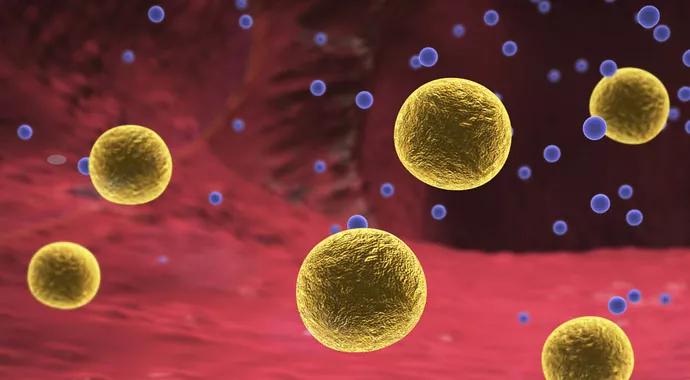PON2 associated with high-density lipoprotein

Persistent inflammation and the generation of reactive oxygen and nitrogen species play a significant role in the development of heart failure. Yet so far researchers have been unsuccessful in developing anti-oxidative treatments for the condition, which affects 1 in 5 people around the world.
Advertisement
Cleveland Clinic is a non-profit academic medical center. Advertising on our site helps support our mission. We do not endorse non-Cleveland Clinic products or services. Policy
Recently, however, a group of investigators found a key enzyme that may lead to such treatments for heart failure patients. The enzyme, paraoxonase 2 (PON2), is expressed in various major organs, including the heart, and — according to the investigators’ study — appears to play a cardioprotective role in both human and experimental heart failure.
“Think of paraoxonase 2 as the calming protein for the heart when it gets overexcited,” says cardiologist Wai Hong Wilson Tang, MD, Director of Cleveland Clinic Lerner Research Institute’s Center for Clinical Genomics. Dr. Tang is the senior author of the study, which was published in Free Radical Biology and Medicine.
PON2 is part of the paraoxonase family, which also includes PON1 and PON3. All three enzymes are associated with high-density lipoprotein (HDL), commonly known as the “good cholesterol.” Previous studies have shown that PON1 and PON3 circulate in the bloodstream and offer protection to various parts of the body. Dr. Tang’s study showed that PON2, by contrast, does not appear to circulate much but is abundant in the heart.
“One way to think about it is that PON1 and PON3 are the traveling soldiers,” Dr. Tang says, “and PON2 is the national guard, which stays at home to counteract any stressors.”
The three enzymes have diverse safeguarding roles, including protecting against lipid peroxidation and oxidative stress, modulating against endoplasmic reticulum stress and regulating of cell proliferation and apoptosis.
The protective powers of PON1 were the first to be discovered after physicians noticed that some agricultural workers became sick and some did not after being exposed to an insecticide named paraoxon. Researchers found that the sick workers had a genetic mutation that made them PON1-deficient.
Advertisement
“That spearheaded the number of people studying paraoxonases for their protective properties,” says Dr. Tang.
While PON1 and PON3 have been studied extensively, few investigations have delved into the role of PON2. Dr. Tang and his colleagues wanted to know if this less-understood enzyme might help researchers figure out how to raise HDL levels in patients with heart disease.
So they transplanted PON2-deficient mouse hearts (PON2-def) and wild type (WT) mouse hearts into live WT mice. First, however, to enhance heart damage, they subjected the hearts to ischemia. After four weeks, the researchers assessed graft function, finding that it was significantly higher in the WT donor mice hearts than the PON2-deficient donor hearts. They also examined reactive oxygen species generation in response to CoCl₂ treatment as an in vitro hypoxia model. They found PON2 deficiency dramatically increased production of reactive oxygen species with CoCl₂ treatment.
In separate experiments, they operated on the live mice to constrict their new hearts’ transverse aortas; the procedure, known as TAC, created pressure overload-induced cardiac hypertrophy and heart failure in the mice.
Echocardiograms of the mouse hearts were performed before TAC surgery and at four and eight weeks post-surgery. Before surgery, the left ventricular internal diameter end diastole was significantly larger in PON2-def mice — illustrating that even before aortic constriction, those hearts were damaged by a lack of PON2.
When the researchers compared cardiac function pre-TAC and eight weeks post-TAC, cardiac function was significantly impaired in the PON-def mice. They also found more severe fibrosis in the PON2-def hearts at four and eight weeks post-TAC.
Advertisement
The researchers compared reactive oxygen species levels in the PON2-def and WT mice hearts after they were harvested and frozen at eight weeks post-TAC. They found a significantly higher level of 2-OHE in the PON2-deficient hearts.
They also used DHE combined with HPLC-fluorescence detection to measure intracellular superoxide production from cells and tissues. They found that pre-incubation of WT tissue samples with PEG-SOD significantly diminished 2-OHE production, confirming that 2-OHE was a product from DHE’s reaction with superoxide instead of other oxidants. They also observed the generation of ethidium after incubation of the tissue with DHE. They found significantly higher 2-OHE/E peak area ratio in PON2-def hearts, which was consistent with the higher level of 2-OHE in PON2-def hearts.
Lastly, the investigators tested potential increased expression of PON proteins in human ischemic cardiomyopathy that may counterbalance increased oxidative stress. They found that PON2 (not PON1 nor PON3) is present in human hearts, even though they have lower PON lactonase activity. They performed mitochondrial ToxGlo assay and measured cellular ATP production in WT and PON2-def mouse cardiomyocytes with and without CoCl₂-induced hypoxia. They found significantly lower ATP levels in PON2-def cardiomyocytes.
“When the heart gets distressed, PON2 congregates into the mitochondria to suppress this overreaction that the cells make when experiencing stress,” Dr. Tang says. “We knew PON2 was expressed in the heart, but we never knew before what it interacted with and how it can protect oxidant stress.”
Advertisement
In the future, the investigators hope to develop drugs or other methods for improving PON2 levels in patients that may be deficient in them in order to guard against or reverse heart failure. Says Dr. Tang: “This points toward more precision and more preventive approaches to heart failure.”
Advertisement
Advertisement

First full characterization of kidney microbiome unlocks potential to prevent kidney stones

Investigators are developing a deep learning model to predict health outcomes in ICUs.

Cleveland Clinic and Johns Hopkins collaboration could help meet need for new therapies

Cleveland Clinic researchers’ finding paves the way for new antiviral approaches

Multicenter collaboration aims to facilitate tracking of neurological activity deep within tissue

Findings illuminate MCEMP1 protein’s role in severe inflammation

Anti-viral immunity identified a novel mechanism in necroptosis

Cleveland Clinic’s new Global Director of Vaccine Development outlines plans, priorities